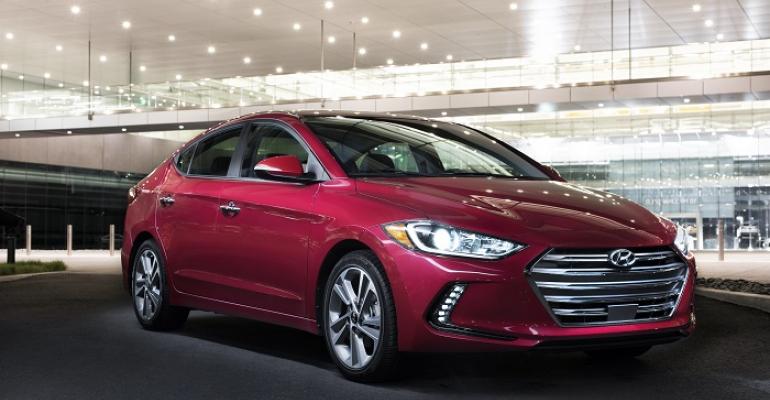Hyundai reveals full details of the sixth-generation Elantra sedan today at the 2015 Los Angeles auto show, including a look borrowed from the larger, current-gen Sonata and two new engines.
The Elantra now wears the Sonata’s hexagonal-shaped grille with horizontal chrome bars, while maintaining a similar profile to the outgoing fifth-gen Elantra.
The compact sedan has “sculpted body forms complemented by smoothly contoured lines,” the automaker says in a statement distributed to media ahead of the car’s debut at the show.
Rear styling features are functional, including the rear-bumper bottom spoiler and deck lid with an expanded trunk edge, both of which make the car more slippery than its predecessor.
Front-wheel air curtains borrowed from the Sonata Hybrid limit turbulence and wind resistance.
Dimensionally, the Hyundai compact is 0.8 ins. (20 mm) longer and 1 in. (25 mm) wider than the model it replaces. Height and wheelbase go unchanged.
A modern, driver-oriented design is the theme of the Elantra’s interior. Judging from a photo, here too the car takes inspiration from the Sonata, with an upper center stack that is similar in shape to that of the D-car’s.

Like many compacts, the Elantra has elements once considered the domain of luxury makes, including “premium soft-touch” materials in key areas, the automaker says.
Further upping the car’s premium feel are optional features such as a segment-first memory driver seat and side mirrors.
Also available are heated front and rear seats, hands-free Smart Trunk technology, adaptive cruise control, a second USB port (primarily for Android Auto smartphone connections) and two audio systems, one with a 7-in. (18-cm) touchscreen and the other with an 8-in. (20-cm) touchscreen integrating a next-gen navigation system.
The bigger screen has improved touch sensitivity for touch-and-drag control, Hyundai says.
High-tension lightweight seat frames improve collision performance, while a multi-firmness seat pad aims to limit driver fatigue during long-distance driving.
Also aiding safety are B-pillars with partial-softening hot stamping, with a reinforced steel section that transitions into a softening section for absorbing side-impact forces.
New Nu 2.0L, Kappa 1.4T
The car’s volume engine will be a 2.0L multiport-injected Atkinson-cycle 4-cyl., part of Hyundai/Kia’s Nu engine family and replacing the current-gen SE and Limited grade’s 145-hp 1.8L 4-cyl.
The new 2.0L makes 147 hp at 6,200 rpm and 132 lb.-ft. (179 Nm) of torque at an estimated 4,500 rpm. It operates with a compression ratio of 12.5:1.
Benefits of Atkinson cycle include reduced pumping loss, as the close timing on the intake valve in the compression stroke is delayed, maximizing the expansion ratio.
Also reducing pumping losses is intermediate-valve-cam phasing technology, while a new electronically controlled thermostat decreases pumping energy.
Piston-cooling jets, which spray oil at the piston’s lower portion, help improve fuel economy.
Hyundai estimates the ’17 Elantra SE and Limited with the Nu 2.0L paired to a 6-speed automatic transmission will achieve 33 mpg (7.1 L/100 km) combined, up from a high of 32 mpg (7.4 L/100 km) in the outgoing 1.8L/6AT model.
The ’17 Elantra 6AT is a new-generation unit, with a redesigned valve body, multi-clutch torque converter and double-angular ball bearings.
The other new engine is a “Kappa” 1.4L 4-cyl., with a single-scroll turbocharger and direct injection, making 128 hp at 5,500 rpm and 156 lb.-ft. (212 Nm) of torque from 1,400-3,700 rpm.
The 1.4L will be available on the Eco grade, due in spring 2016, and mated to Hyundai/Kia’s 7-speed DCT.
It has an integrated cylinder head and exhaust manifold said to improve fuel economy 5%-7% at high engine speeds.
Estimated fuel economy of the Elantra Eco is 35 mpg (7.0 L/100 km) combined, tying the new Honda Civic sedan’s class-leading figure. The Civic has a 174-hp 1.5L turbo DI 4-cyl. mated to a CVT.
In pre-show materials, Hyundai makes no mention of a ’17 Sport grade or engine befitting such a model. The ’16 Elantra Sport has a 173-hp 2.0L with direct injection.
As with many new models, the Hyundai C-car is lighter and more rigid than its predecessor, with 53% high-strength steel content in its chassis, up from 21% in the ’16 model.
Torsional rigidity rises 29.5% and bending strength grows 25.3% due to the HSS content, as does vehicle quietness. Also helping quell cabin noise are 40 times more structural adhesives at high-stress points on the chassis.
Suspension updates to the Elantra for ’17 include newly angled rear shock absorbers and an increase in rear-bushing diameter for comfort, handling, stability and durability reasons, Hyundai says.
The new Elantra sedan goes on sale in the U.S. in January and launches into a relatively fresh C-segment.
The Honda Civic sedan is arriving at U.S. dealers now, while today at the show Nissan is expected to debut a refreshed Sentra and Subaru will reveal a concept Impreza 4-door.
Along with the ’11-’14 Sonata midsize sedan, the outgoing fifth-generation Elantra 4-door was one of Hyundai’s most successful redesigns, boosting the automaker’s fortunes sharply in the U.S. C-car segment when it debuted in 2011.
WardsAuto data shows U.S. Elantra volume went from 132,246 in 2010, just before the fifth-gen’s debut, to 247,912 in 2013, the car’s best year.
Elantra sales, which include lower-volume coupe and hatchback body styles, were up 10.9% through October to 209,830, placing it third in WardsAuto’s Upper Small car group after the Toyota Corolla (306,693) and Civic (277,538).




